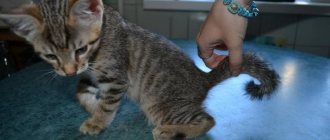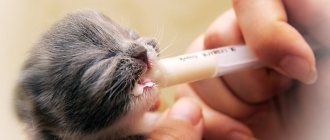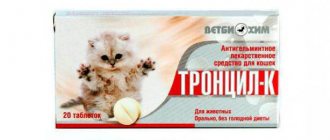Veterinary pharmacies offer a wide range of all kinds of anthelmintic drugs or, as they are commonly called, deworming medications. It is fundamentally important to learn to understand what their fundamental difference is, what the principle of action is and whether the uncontrolled use of such drugs is safe.
The process of removing worms from the body is called deworming. It is necessary to give anthelmintics only after treatment against fleas and ticks, because Many blood-sucking insects are intermediate hosts in the development chain of parasites and become their carriers.
How often should I give deworming tablets?
Anti-worm tablets for preventive purposes are given once a quarter (every three months). For therapeutic purposes, the medicine is given at the time of detection of parasites in the dosages specified in the instructions, with mandatory re-administration after 10-14 days.
When to give the tablets?
Usually, taking anthelmintic drugs is not associated with food intake. But for a greater therapeutic effect, it is better to give the drugs 1.5-2 hours before meals or with the same interval after. It is necessary to alternate taking it at night and in the morning, because... Different types of helminths show activity and migration between the intestines and stomach at different times of the day.
How do cats get rid of worms after taking medication?
Parasites come out naturally through the rectum with feces or vomit. If, after giving the medicine, an animal vomits parasites once and without worsening its general condition, this is considered as normal, and there is no reason to worry. Often this phenomenon does not go unnoticed, and owners can assess the degree of invasion (infection) of the cat.
Is it possible to give a pregnant cat deworming tablets?
It is possible to give anthelmintic drugs to pregnant women, but taking into account the individual selection of the drug, the general condition of the animal, as well as the period of pregnancy. There are a number of drugs approved for use by pregnant women to avoid the risk of intrauterine infection of future offspring. Tablets can also be given to a nursing cat, unless prohibited by the instructions for the drug.
In what form are the most effective medications for worms: drops, tablets or suspensions?
The effectiveness of anthelmintic drugs depends more on the main active ingredient and the correctness of its selection than on the form of release.
Classification of anthelmintic drugs
All deworming drugs are divided into:
Mechanism of action:
- have a narcotic effect on the nervous system of worms;
- paralyze the muscle layer, stopping the movement of parasites;
- disrupt the metabolism of worms;
- destroy the cuticle (outer shell) of helminths, “burning” the cells of which it consists (most often they cause intoxication of the cat’s body, therefore they are considered the most unsafe).
By name of the parasites affected:
- anti-trematodes.
- antinematodes;
- anticestodes;
According to the active substance, derivatives:
- bithionol (against cestodes (tapeworms) with antifungal action);
- ditrazine (used for suspected strongyloidiasis);
- milbemycin oxime (strong substances that kill adult roundworms and their larvae, dirofilariasis, and demodex mites);
- naphthamon (they work well against toxocara, but they affect the liver, so they are not prescribed for problems with its functioning);
- piperazine (effective exclusively against roundworm nematodes; tapeworms and flukes are absolutely not sensitive);
- praziquantel (paralyze trematodes and cystodes);
- carbon tetrachloride (previously used for strongylatosis, but was banned due to high toxicity);
- fasciolin or hexachloroethane (effective for feline opisthorchiasis and kill liver flukes, but have a negative effect on the liver at the slightest overdose);
- phenasala (against intestinal cestodiasis);
- fenbendazole (neutralizes cestodes and nematodes, is not effective against cucumber tapeworm; given for 3 days in a row to obtain the desired effect);
- phenothiazine (effective against nematodes (ascaris);
- emodepside (a new group of substances against nematodes for cats, affecting sexually mature helminths, as well as their eggs and larvae).
The classification by chemical composition is far from complete, but these substances are most often found in modern anthelmintic products for cats. Also, this division is very conditional, because Most often, the drugs are complex, including several substances that do not contradict each other in combination. The names of many anthelmintic tablets are often based on the main active ingredient.
There is no classification as “good pills” and “bad pills” that pet owners love to use. With the correct selection of name and dosage, any drug will show its maximum effectiveness with minimal side effects.
How are anthelmintics given?
Anthelmintics for cats and kittens are available in four different forms:
Pills
How to give a cat an anti-worming tablet? Solid forms of medications are given to cats in three ways:
- crush the drug into powder, mix with water and pour through the toothless edge with a syringe without a needle, after fixing it in a towel (if necessary);
- add the tablet to food or a piece of some cat treat;
- open the mouth of the restrained cat, place the whole tablet slightly to the side of the root of the tongue, close the mouth and stroke the neck until the animal makes a swallowing movement and licks its lips. You can give it to drink from a syringe.
Drops on the withers
The drops on the withers “speak” for themselves. The drug is applied to the skin in the area of the withers - neck and between the shoulder blades to prevent licking of the drug. Sometimes light rubbing may be necessary. It does not bring any discomfort to the animal, it is very convenient to use if the cat completely refuses any oral medications (by mouth).
Pastes
Pastes are initially produced in packages in the form of syringes with a narrow spout and marked markings, according to the dosage. A docile and non-aggressive animal is placed on a hard surface, pressed against the surface at the withers, the end of a dispenser syringe is inserted through the toothless edge and the required volume of medicine is squeezed out. If the cat is aggressive, it is recommended to restrain it by wrapping it in a rough cloth, blanket or towel, also administering the medicine through the toothless edge. But usually this is not required, because... The pastes have a pleasant smell for cats and are eaten willingly and without effort. For kittens, pastes are diluted with water to form emulsions and filled in using a disposable syringe, because... For them, the consistency of the paste is too thick to swallow.
Suspensions
Suspensions always come complete with dispensers. If suddenly there is no dispenser, you can use a regular disposable syringe without a needle. The principle of administering the medicine is similar to pastes. Typically, liquid medications have a pleasant taste, so cats swallow them willingly.
Additional recommendations
There are a number of actions that breeders and animal psychologists do not recommend doing. For example, you should not wrap your pet in a blanket to feed medicine. You should not show the cat the drug in advance, but all preparatory procedures must be carried out in advance. To carefully open the mouth and not make your pet feel bad, you need to insert your fingers between the teeth and then confidently push the teeth apart. To make the animal docile, it is recommended to hold it by the withers. You can tell that a cat has swallowed the medicine by licking it. After taking the drug, you need to feed or water the animal, depending on the method of feeding the anthelmintic used.
Typically, deworming tablets are endowed with a special taste and smell, which a cat’s keen sense of smell can easily distinguish even as part of their favorite food, so it is recommended to keep the medicine in the refrigerator for several hours. The low temperature will mask the bitterness and unpleasant odor.
The first stage of a cat’s emotional reaction to the owner’s actions is increased resistance.
Animal psychologists say that any cat, when it senses danger, exhibits 3 phases of emotional state:
- Protest. The cat strenuously resists manipulation - it dodges, scratches, and snaps.
- Imaginary death. The animal freezes, creating the impression of lifelessness.
- Escaping.
Thus, it is correct to give anthelmintic medication in the second phase. It is in this low-emotional phase that the animal will allow its mouth to open, will not harm the owner or itself, and will be able to swallow the medicine. If, however, it was not possible to feed the tablet or liquid form to your pet, it is better to visit a veterinary clinic or call a veterinarian at home.
Medicines for worms: main list, names, prices
In veterinary medicine, complex drugs are most often used against several types of different parasitic worms. To choose a medicinal product, it is best to contact a veterinarian, who will prescribe the drug based on the animal’s health condition and having done a preliminary fecal analysis to determine the type of helminthic infestation (type of parasites). The initiative of owners of mustachioed pets in a veterinary pharmacy in the form of the phrase “give something for worms to the cat” can lead to serious consequences!
All anthelmintic drugs are difficult to tolerate by any living organism - this is always a burden on the liver and immune system. An incorrectly calculated dosage or an incorrectly selected drug is a real risk of death of the animal!
It is strictly forbidden to give cats human deworming medications. It is almost impossible to safely calculate the current dosage for a person by the weight of a cat.
Absolutely all deworming tablets for cats are accompanied by instructions with a detailed description of the dosage calculation, methods of use and warnings.
Deworming tablets
Dirofen plus 35-70 rub.Tablets for kittens: 1 tablet/kg; for adult cats: 1 tablet/5 kg. Three days in a row once, repeated after 2 weeks. Contraindications - Do not violate the treatment regimen. Not for kittens under 3 weeks of age. Pregnant women - no later than 3 weeks before birth, breastfeeding - no earlier than 2-3 weeks after birth. In case of overdose: depression, drooling, indigestion, lack of appetite. |
Milbemax 200-400 rub.For cats: 2-4 kg – 0.5 tablet; 4-8 kg – 1 tablet. For kittens: 0.5-1 kg – 0.5 tablet; 1-2 kg – 1 tablet. One time. Contraindications: pregnant women under medical supervision. Not allowed: up to 6 weeks for kittens who are malnourished, have kidney or liver failure. Allergic reactions are possible. |
Drontal60-80 rub./tab.) 1 tablet/4 kg of weight once in the morning feeding. Contraindicated: individual sensitivity to components, age under 3 weeks and weight less than 1 kg, pregnancy. |
Trontsil K180-250 rub. Calculation of dosage by weight: up to 1 kg - ¼ tablet, 1-2 kg - ½ tablet, 2-3 kg - ¾ tablet, 3-4 kg - 1 tablet, 4-5 kg - 1 and ¼ tablet. |
Febtal35-55 rub. Once in the morning for three days. 1 tablet/3 kg weight. It is better to crush it in food. |
Poliverkan200-300 rub. Dissolve in water. Once, repeated after 10 days. 0.5 kg – 0.25 briquettes; 1-5 kg – 0.5 briquettes; Contraindications: hypersensitivity, liver dysfunction, age up to 30 days. |
Prazitel50-80 rub. Form for adult cats: 1 tablet/4 kg weight; for kittens: 1 tablet/kg. One time. Repeat after 10 days in case of severe infection. Possible: individual reaction, increased salivation. |
Kanikquantel Plus45-60 rub. 1 tablet/10 kg body weight with food. Can be crushed and diluted in 10 ml of water, giving 1 ml/kg of suspension. Contraindicated: pregnancy, feeding, kittens under 3 weeks of age. |
Fenpraz120-137 rub. Inside, once in the morning. 1 tablet/4 kg weight. Not allowed: for pregnant women - no later than 10 days before the expected lambing. |
Anti-worm suspensions
40-60 rub. 1 ml/kg body weight once in the morning. Repeat in 10 days. 3 weeks before birth and 2-3 weeks after. |
Prazitel100-150 rub. Once, repeated after 10 days at a dose of 1 ml/kg. First half of pregnancy and kittens up to 3 weeks of age. Brief drooling may occur. |
Febtal combo50-80 rub. Dose: 1 ml/kg. For weights up to 0.5 kg, the collected dose is diluted with 0.3 ml of water. Pregnancy, feeding offspring, kittens up to 3 weeks old. |
Fenpraz100-125 rub. 1 ml/2 kg weight with a small amount of water in a syringe or food. Give slowly! Once in the morning or evening. For pregnant women, under the supervision of a doctor and no later than 1.5 weeks before birth. |
Anthelmintic drops on the withers
Profender200-310 RUR/pipette. 1 pipette of the required volume per 1 animal, depending on the size of the animal: 0.5-2.5 kg – 0.35 ml; 2.6-5 kg – 0.7 ml; 5-8 kg – 1.2 ml. For cats heavier than 8 kg, the calculation is 0.14 ml/kg. It drips onto the withers (neck and between the shoulder blades). Individual reaction. Do not apply to wet or damaged skin. Kittens under 8 weeks and less than 0.5 kg. Itching and local irritation. |
Inspector150-350 rub./pipette. 1 pipette according to the weight of the animal: 1-4 kg – 0.4 ml, 4-8 kg – 0.8 ml. Once on the withers on the skin. Pregnancy, nursing, weighing up to 1 kg - according to indications and under the supervision of a doctor. Sometimes a local reaction in the form of itching and irritation. |
Helminthal100-200 rub./pipette. On the skin of the withers in 3-4 different places, excluding licking. 1 pipette – 1 animal: up to 4 kg – 0.4 ml; 4-10 kg – 1 ml. One time. Individual reaction, kittens younger than 7 weeks, weak, sick and exhausted cats, pregnancy, lactation, kidney and liver problems. Rare local reactions (irritation and itching). |
Prazicide complex160-270 rub./pipette. Up to 1 kg kittens – 1 pipette 0.3 ml; more than 1 kg – 0.6 ml (2 pipettes); cats up to 5 kg – 1 pipette 0.85 ml; over 5 kg – 2 pipettes 1.7 ml. One time. Kittens under 2 months old, lactating and pregnant individuals, sick and exhausted. |
Broadline450-570 RUR/pipette. On the skin in the withers area once, according to the dosage markings on the syringe: up to 2.5 kg - 0.3 ml; 2.5-7.5 kg – 0.9 ml; 7.5-10 kg – 1.2 ml. Impaired kidney and liver function, weak and emaciated individuals, kittens up to 7 weeks old, lactation, pregnancy. |
Antihelminthic pastes
Dirofen paste 20120-200 rub. Once in the morning, 1 mg of paste per 1 kg of weight immediately into the mouth or with food. Repeat after 1.5 weeks. Kittens under 3 weeks of age, sick, malnourished and recovering cats. Pregnant and breastfeeding women should use caution under the supervision of a doctor 3 weeks before and 2-3 weeks after birth. In case of overdose, obvious signs of intoxication: depression, refusal to feed, vomiting. |
Kaniverm210-240 rub./4 ml. 0.5 ml paste/0.5-2 kg weight; 1 ml/2-5 kg depending on the intensity of the invasion. Do not combine with dairy products. Repeat after 3 weeks. Hypersensitivity to components, liver damage. Pregnant women are prohibited from exceeding the dose. |
What to do in case of poisoning during deworming?
In the process of treating helminthic infestations, you can encounter two types of poisoning:
- poisoning due to the accumulation of harmful substances in the body due to the massive decay of helminths (especially with severe infection);
- poisoning directly with anthelmintic drugs due to incorrectly calculated dosage and its excess.
Urgently see a veterinarian if:
- the cat became apathetic and lethargic;
- the animal does not drink or eat anything at all;
- there is diarrhea or vomiting;
- loss of consciousness.
You should not try to remove a sick animal from an obvious state of intoxication yourself. It is likely that gastric and intestinal lavage will be required, which is very dangerous to do on your own at home without the appropriate skills and experience.
In the hospital, in addition to washing the intestines and stomach, the animal will be given various detoxifying solutions - this is the only way to reduce the effect of total poisoning. It is possible that surgical intervention will be required due to blockage of the intestines by helminthic balls in case of severe infestation.
To prevent such conditions it is necessary:
- clearly calculate the dosage, depending on the weight of the animal (see the instructions for the drug or ask your doctor or veterinarian). It is prohibited to exceed the dosage, regardless of the intensity of the invasion;
- do not treat for worms if the cat is not healthy;
- monitor your general condition after taking the medicine;
- do not wait for infection, carrying out quarterly treatment for worms for prevention.
Recommended against the background of giving anthelmintic drugs:
- inject “Gamavit” (biogenic stimulant, vitamin complex, tonic and detoxifying drug) at a dose of 0.1 ml/kg subcutaneously in the withers area;
- 4-6 hours after administering the drug, give any adsorbent (0.5-1 tsp enterosgel, 1 tablet of activated carbon or 0.5 tsp in 30 ml of polysorb water);
- monitor the cat's going to the toilet: within 6-10 hours after giving the medicine for worms, the cat must go “big”. If this does not happen, you need to give 5-7 ml of a lactulose-based laxative - Duphalac or Lactusan (in syrup).
Author:
Grinchuk Ekaterina Andreevna veterinarian
Side effects
Most often, the principle here is the same - just as you give a cat medicine for worms, that’s how it works on him. If you follow the regulations and buy drugs in specialized stores, the risk is minimal. Cats and cats are also different. Perhaps your pet will be a little crippled by the dewormer due to the individual characteristics of the body, but most likely not.
If we talk about manifestations, these are standard signs of food poisoning:
- vomit;
- nausea;
- diarrhea.
Less often - foam at the mouth, dermatitis, more often allergies.











